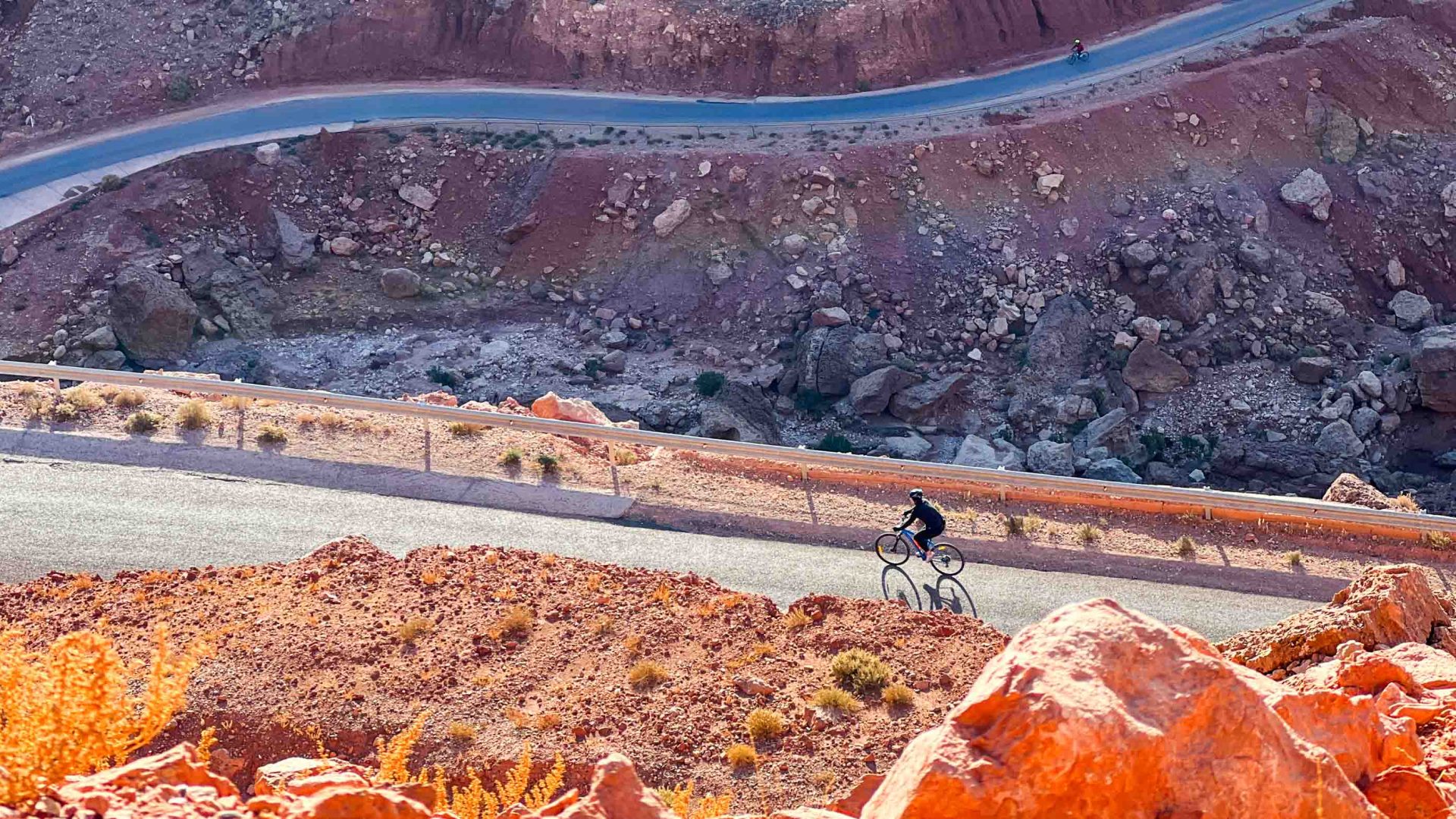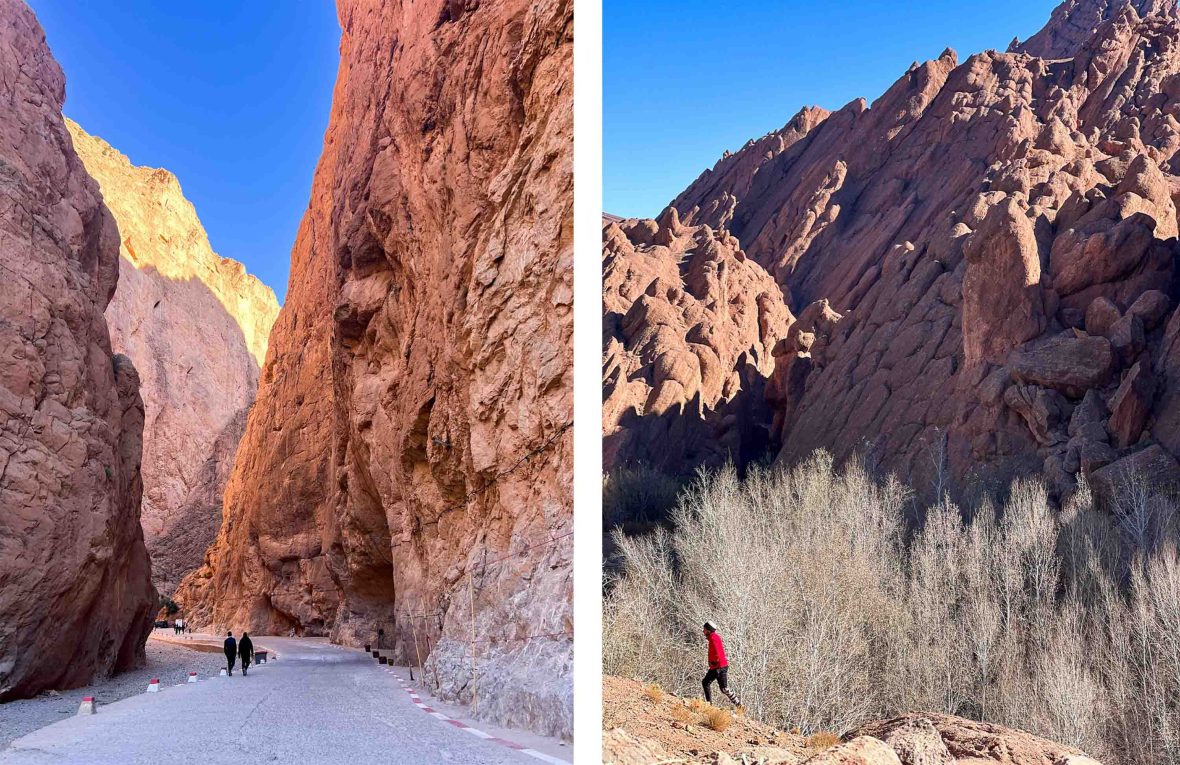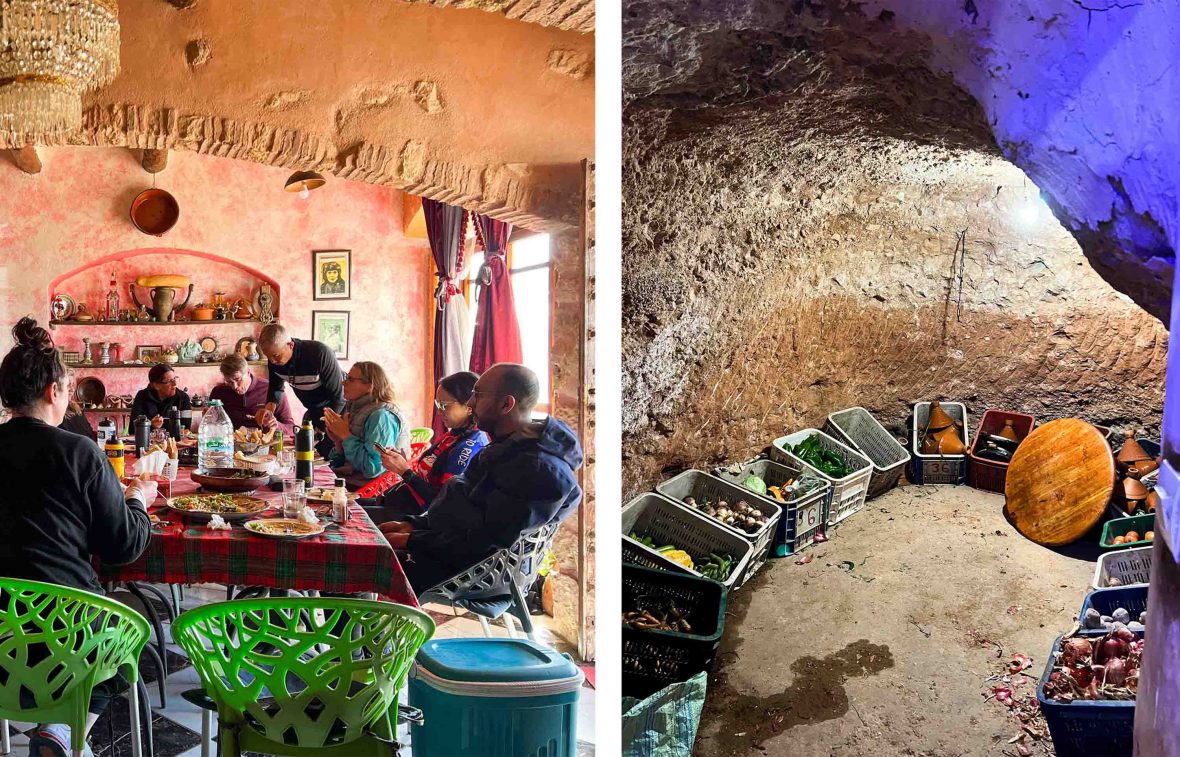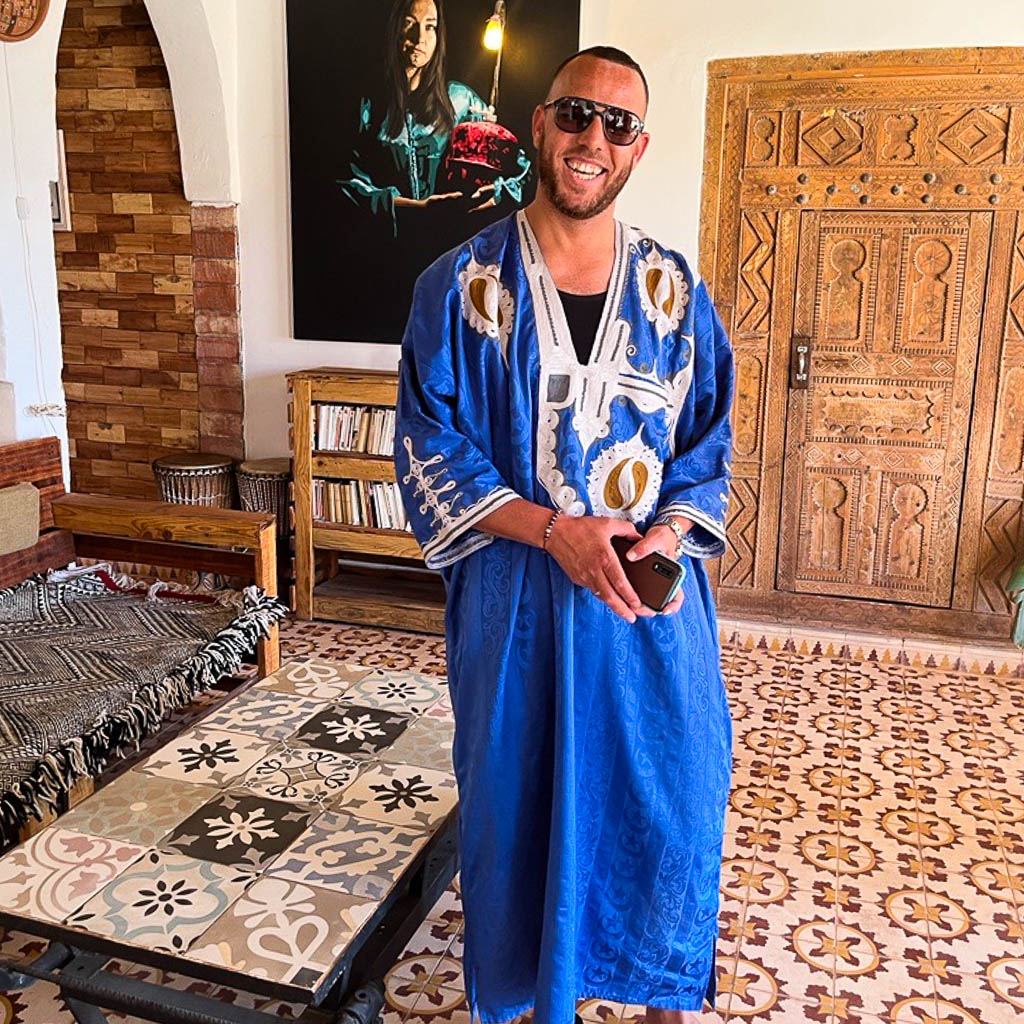
E-biking through the landscapes and cultures of Morocco gave Shivya Nath a chance to process our changing world, the effects of climate change, and the deeper connection we can experience with nature and communities when we slow down.


E-biking through the landscapes and cultures of Morocco gave Shivya Nath a chance to process our changing world, the effects of climate change, and the deeper connection we can experience with nature and communities when we slow down.
The morning was so cold that despite wearing five layers—along with gloves, a beanie and my cycling helmet—I couldn’t feel my face or fingers. As we pedaled up the winding arid slopes of the dramatic High Atlas mountains, the river Mgoun babbled gently along, filling the valley below with walnut, fig and almond trees.
Behind me lay the mud houses and kasbah (fortress) of Boughrare, the mountain village our trip leaders Mohamed Azabi and Rashid Azaby had grown up in, and where we’d spent the previous night. The sun gradually climbed above the ridgelines, bathing the mountains, though I couldn’t feel its warmth yet. Further along, a thick morning mist had engulfed the foothills, from which rose other villages, kasbahs and mud houses, their chimneys steaming smoke from bread baking in stone ovens.
Despite the cold that morning, I remember thinking this must be the most unforgettable day of our two-week e-biking trip across Morocco. But then again, I’d thought that every day since we’d set out from Marrakech.
My partner and I joined 11 other cyclists, two local guides and two support vehicles on Intrepid Travel’s ‘Cycling Morocco’ trip to spend two weeks e-biking across the length and breadth of the country—from the ancient coastal city of Tangier, along the Atlantic Ocean and Mediterranean Sea, into the Rif mountains surrounding Chefchaouen and Fez, past the Middle Atlas, into the Sahara Desert, along the High Atlas, and looping back into Marrakech. Here’s what I learned along the way.
Morocco’s diversity of landscapes is underrated
Riding on average 30-50 kilometers every day—through undulating terrain, steep switchbacks, gentle coastal roads, and challenging mountain inclines—I was surprised by how much the scenery changed.
Each morning, I’d compare the landscape to somewhere I’d been before; the azure Mediterranean coast of Turkey, the panoramic Silk Road passing through Iran, the dramatic Trans-Himalayan valleys of Northern India, the high altitude lake region of Tajikistan, and the cactus-strewn desert of Baja California. A few days in though, I ran out of comparisons. This was Morocco, I realized. Stunning, diverse and underrated.
It wasn’t just the landscapes that changed. We noticed the cultural influences—French, Spanish, Arabic, Jewish, Amazigh/Imazighen—change too. In Marrakech, French could be heard across the streets, but in the port city of Tangier, separated from Spain only by the Port of Gibraltar, Spanish became the second language.
The ancient, awe-inspiring Moroccan architecture of Chefchaouen and Fez made clear its influence on Andalucia (not the other way around). In the blue city of Chefchaouen, I learned that the color was first derived from natural dyes used ritually by Jews—who’d once found protection from prosecution in the city’s mellah, or Jewish quarters.
I learned that due to rapid warming on the planet, Morocco is facing its sixth consecutive year of drought. We crossed upscale golf resorts and luxury pool villas, then made our way along a bridge over the once perennial Tensift River—dry as far as the eye could see.
We rode past numerous nomadic settlements, but it was in the High Atlas that Indigenous Imazighen (singular ‘Amazigh,’ popularly called ‘Berber’) culture seemed most rooted. Berber was a term coined by Romans, meaning barbarian—a reference they used for anyone different from them, including the Persians, Phoenicians and northern Europeans, and more reflective of their own unevolved outlook of the world.
The Indigenous people of this region prefer to call themselves Imazighen—the free people—who, for centuries, have led nomadic lives, following the water with their families and animals. But that is changing.

While cycling on the outskirts of Marrakech, I learned that due to rapid warming on the planet, Morocco is facing its sixth consecutive year of drought. On average, hotels consume 310 liters of water per guest night in Morocco, which is mostly sourced from the public network or from wells, while golf courses in hot, dry climates may require as much as six acre-feet of water per acre per year.
And so we crossed upscale golf resorts and luxury pool villas, then made our way along a bridge over the once perennial Tensift River—dry as far as the eye could see. The river originated in the High Atlas, and cycling on their parched, if still breathtaking, slopes a few days later told a similar story.
Despite cycling in the peak of the rainy season, we only ever experienced a light drizzle on one afternoon in Chefchaouen. I discovered from our guides that there should’ve been snow on the high peaks, and the Ziz, Dades and other rivers we cycled along were only a fraction of their usual flow rates. A hydropower plant we crossed was on pause due to alarmingly low water levels. The vegetables don’t taste good this year because the land is so dry, a young Moroccan friend told us, as I dug into endless vegan tajines.
The vegetables certainly became more flavorful as we journeyed deeper into the countryside, especially in the High Atlas where dry, thirsty landscapes would magically give way to an oasis fed by a perennial mountain spring—creating valleys flourishing with Imazighen settlements alongside date and fishtail palms, walnut and fig trees, and veggie and herb gardens.
Wandering through one such oasis with a local guide, I was told that after the devastating earthquake in September 2023, more springs had sprung to life, filling the dry High Atlas valleys with a relative abundance of water.
If we weren’t cycling, would I have noticed the changing landscape as intricately, or felt as connected to the Moroccan outdoors, I wondered.
In the Sahara, we met Imazighen whose nomadic families, for centuries past, roamed the desert with their animals, following water and vegetation. But with extreme scarcity of both, they’ve traded their nomadic lives for tourism jobs. I would read later that rainfall in the monsoon of 2023 was 67 percent lower than a usual year, and the heat, in turn, exacerbated the water crisis through excess evaporation from dams.
Growing tourism too, has been stressing precious water resources. Tourists are known to use water more liberally, and the majority of the 1,500+ riads (traditional multi-storied houses centered around a courtyard garden, many of them now guesthouses) across the old medina of Marrakech feature swimming pools—an ‘invisible burden’ that isn’t accounted for in the economic value created by tourism, asking the question—with no easy answers available—how much water is being used by these pools.

As we set out for a new destination almost every day, in some ways it felt like we rushed along too quickly. I’d have liked to linger longer in Tangier or Chefchaouen, catch another sunset in the Sahara, and immerse deeper in a traditional High Atlas village.
But at the same time, being on two wheels lent a slowness to our daily journeys. Instead of rushing past in a flight or even a train, bus or car, we slowly wheeled through—feeling the wind, hearing the ocean, watching the shades of the mountains change, experiencing every curve and every slope.
Passing through remote villages, excited kids lined up on the road to high-five our troop, and locals often called out greetings of azul, salam or bonjour (in the Amazigh language, Arabic and French respectively). If we weren’t cycling, would I have noticed the changing landscape as intricately, or felt as connected to the Moroccan outdoors, I wondered.

Famished after long cycling rides, we often feasted at carefully chosen, small, locally owned restaurants. On a rest day in Chefchaouen, we embarked on a stunning hike to a local olive and herbs farm up in the mountains. In Fez, we visited a local women’s cooperative to see ceramics (like the famous tajine) in the making. In the High Atlas, our accommodation was a family-owned mountain gîte—a traditional guesthouse with a cave room for cold storage of vegetables and a stone oven to bake fresh bread.
When we visited their hometown of Boughrare, Mohamed and Rashid invited us to meet their family. I learned that Mohamed’s father—like many generations before him—continues to live a nomadic life, spending long months in a mountain cave where he tends his herd of sheep and goats. But Mohamed enjoyed studying and felt like he wasn’t cut out for the harshness of his forefathers’ lives. He studied biology, decided on an adventurous life, and returned to his High Atlas village to lead treks locally.
As a lead guide with Intrepid Travel, he has the opportunity to meet people from around the world, cycle frequently across the country, and go on his own travels in between work trips. At heart, he’s still a nomad, but of a different kind.
As a travel writer, I’ve often wondered where the balance lies. On the one hand, tourism contributes to climate change and often overdraws local resources like water. But on the other, it can offer remote communities—who might no longer be able to sustain their once self-sufficient lifestyle due to the impact of climate change—the opportunity to build alternate livelihoods through tourism. Pedaling through Morocco was a reminder of this complex reality, and a chance to observe the uplifting power of conscious travel.
***
Adventure.com strives to be a low-emissions publication, and we are working to reduce our carbon emissions where possible. Emissions generated by the movements of our staff and contributors are carbon offset through our parent company, Intrepid. You can visit our sustainability page and read our Contributor Impact Guidelines for more information. While we take our commitment to people and planet seriously, we acknowledge that we still have plenty of work to do, and we welcome all feedback and suggestions from our readers. You can contact us anytime at hello@adventure.com. Please allow up to one week for a response.

Shivya Nath grew up in the Indian Himalayas, and is an award-winning travel writer, author and sustainable tourism consultant. She pursued a nomadic life for nearly seven years, living with remote communities around the world, and writing stories at the intersection of travel, the environment and local communities. She is the founder of Climate Conscious Travel, where she works with destinations and businesses to integrate community-centric climate action in tourism offerings.






Can't find what you're looking for? Try using these tags: